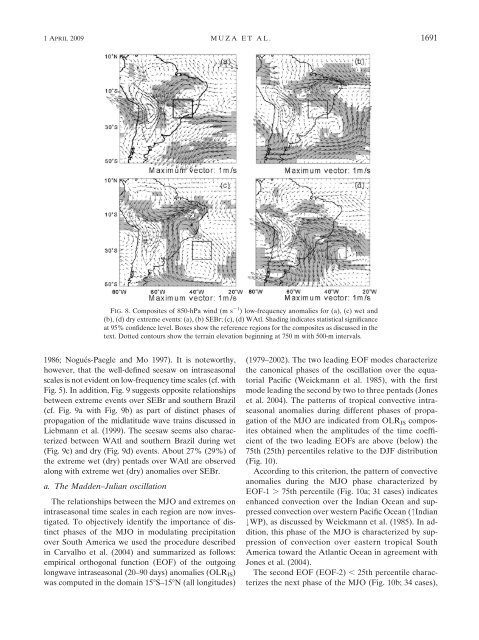Arquivo do Trabalho - IAG - USP
Arquivo do Trabalho - IAG - USP
Arquivo do Trabalho - IAG - USP
Create successful ePaper yourself
Turn your PDF publications into a flip-book with our unique Google optimized e-Paper software.
1APRIL 2009 M U Z A E T A L . 1691FIG. 8. Composites of 850-hPa wind (m s 21 ) low-frequency anomalies for (a), (c) wet and(b), (d) dry extreme events: (a), (b) SEBr; (c), (d) WAtl. Shading indicates statistical significanceat 95% confidence level. Boxes show the reference regions for the composites as discussed in thetext. Dotted contours show the terrain elevation beginning at 750 m with 500-m intervals.1986; Nogués-Paegle and Mo 1997). It is noteworthy,however, that the well-defined seesaw on intraseasonalscales is not evident on low-frequency time scales (cf. withFig. 5). In addition, Fig. 9 suggests opposite relationshipsbetween extreme events over SEBr and southern Brazil(cf. Fig. 9a with Fig. 9b) as part of distinct phases ofpropagation of the midlatitude wave trains discussed inLiebmann et al. (1999). The seesaw seems also characterizedbetween WAtl and southern Brazil during wet(Fig. 9c) and dry (Fig. 9d) events. About 27% (29%) ofthe extreme wet (dry) pentads over WAtl are observedalong with extreme wet (dry) anomalies over SEBr.a. The Madden–Julian oscillationThe relationships between the MJO and extremes onintraseasonal time scales in each region are now investigated.To objectively identify the importance of distinctphases of the MJO in modulating precipitationover South America we used the procedure describedin Carvalho et al. (2004) and summarized as follows:empirical orthogonal function (EOF) of the outgoinglongwave intraseasonal (20–90 days) anomalies (OLR IS )was computed in the <strong>do</strong>main 158S–158N (all longitudes)(1979–2002). The two leading EOF modes characterizethe canonical phases of the oscillation over the equatorialPacific (Weickmann et al. 1985), with the firstmode leading the second by two to three pentads (Joneset al. 2004). The patterns of tropical convective intraseasonalanomalies during different phases of propagationof the MJO are indicated from OLR IS compositesobtained when the amplitudes of the time coefficientof the two leading EOFs are above (below) the75th (25th) percentiles relative to the DJF distribution(Fig. 10).According to this criterion, the pattern of convectiveanomalies during the MJO phase characterized byEOF-1 . 75th percentile (Fig. 10a; 31 cases) indicatesenhanced convection over the Indian Ocean and suppressedconvection over western Pacific Ocean ("Indian#WP), as discussed by Weickmann et al. (1985). In addition,this phase of the MJO is characterized by suppressionof convection over eastern tropical SouthAmerica toward the Atlantic Ocean in agreement withJones et al. (2004).The second EOF (EOF-2) , 25th percentile characterizesthe next phase of the MJO (Fig. 10b; 34 cases),
















